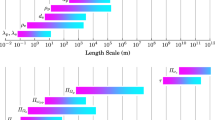Abstract
A three-dimensional electromagnetic particle-in-cell code with Monte Carlo collision (PIC-MCC) is developed for MIMD parallel supercomputers. This code uses a standard relativistic leapfrog scheme incorporating Monte Carlo calculations to push plasma particles and to include collisional effects on particle orbits. A local finite-difference time-domain method is used to update the self-consistent electromagnetic fields. The code is implemented using the General Concurrent PIC (GCPIC) algorithm, which uses domain decomposition to divide the computation among the processors. Particles must be exchanged between processors as they move among subdomains. Message passing is implemented using the Express Cubix library and the PVM. We evaluate the performance of this code using a 512-processor Intel Touchstone Delta, a 512-processor Intel Paragon, and a 256-processor CRAY T3D. It is shown that a high parallel efficiency exceeding 95% has been achieved on all three machines for large problems. We have run PIC-MCC simulations using several hundred million particles with several million collisions per time step. For these large-scale simulations the particle push time achieved is in the range of 90–115 ns/particle/time step, and the collision calculation time in the range of a few hundred nanoseconds per collision.
Similar content being viewed by others
References
R. Biasca, D. Cooke, and D. Hastings. Simulation of the critical ionization velocity: Effects of using physically correct mass ratios. Journal of Geophysical Research, 97: 6451–6465, 1992.
C. K. Birdsall. Particle-in-cell charged-particle simulations, plus Monte Carlo collisions with neutral atoms, PIC-MCC. IEEE Transactions on Plasma Science, 19: 65–85, 1991
C. K. Birdsall and A. B. Langdon. Plasma Physics via Computer Simulation. McGraw-Hill, New York, 1985.
P. Burger. Elastic collisions in simulating one-dimensional plasma diodes on the computer. Physics of Fluids, 10: 658–666, 1967.
M. Cho and D. Hastings. An analytical and particle simulation study of localized semivacuum gas breakdown phenomena on high-voltage surfaces in low earth orbit. Physics of Fluids B, 4: 2614–2625, 1992.
V. K. Decyk, S. R. Karmesin, A. deBoer, and P. C. Liewer. Optimization of particle-in-cell codes on RISC processors. Computers in Physics (in press), 1996.
G. Fox, M. Johnson, G. Lyzenga, S. Otto, J. Salmon, and D. Walker. Solving Problems on Concurrent Processors, vol.1. Prentice-Hall, New Jersey, 1988.
R. W. Hockney and J. W. Eastwood. Computer Simulation Using Particles. McGraw-Hill, New York, 1981.
P. C. Liewer and V. K. Decyk. A general concurrent algorithm for plasma particle-in-cell simulation codes. Journal of Computational Physics, 85: 302–322, 1989.
S. Machida and C. Goertz. The electromagnetic effect on the critical ionization velocity phenomena. Journal of Geophysical Research, 93: 11,495–11,506, 1988.
M. Surendra, D. Graves, and G. Jellum. Self-consistent model of a direct-current glow discharge: Treatment of fast electrons. Physics Review A, 41:1112–1125, 1990.
V. Vahedi. Modeling and simulation of RF discharges used for plasma processing. Ph.D Thesis, University of California at Berkeley, 1993.
D. Vender and R. Boswell. Numerical modeling of low pressure RF plasmas. IEEE Transactions on Plasma Science, 18: 725–732, 1990.
J. Villasenor and O. Buneman. Rigorous charge conservation for local electromagnetic field solvers. Computer Physics Communications, 69: 306–316, 1992.
J. Wang, P. Liewer, and V. Decyk. 3D electromagnetic plasma particle simulations on a MIMD parallel computer. Computer Physics Communications: 87, 35–53, 1995.
J. Wang and J. Brophy. 3-D Monte Carlo particle-in-cell simulations of ion thruster plasma interactions. AIAA paper 95-2826, 1995.
J. Wang, R. Biasca, and P. Liewer. 3-D electromagnetic Monte Carlo particle-in-cell simulations of critical ionization velocity experiments in space. Journal of Geophysical Research, 101, A1: 371–382, 1996.
K. S. Yee. Numerical solution of initial boundary value problems involving Maxwell's equations in isotropic media. IEEE Transactions on Antennas and Propagations, 14: 302–307, 1966.
Author information
Authors and Affiliations
Rights and permissions
About this article
Cite this article
Wang, J., Liewer, P. & Huang, E. Three-dimensional electromagnetic particle-in-cell with Monte Carlo collision simulations on three MIMD parallel computers. J Supercomput 10, 331–348 (1997). https://doi.org/10.1007/BF00227862
Issue Date:
DOI: https://doi.org/10.1007/BF00227862




